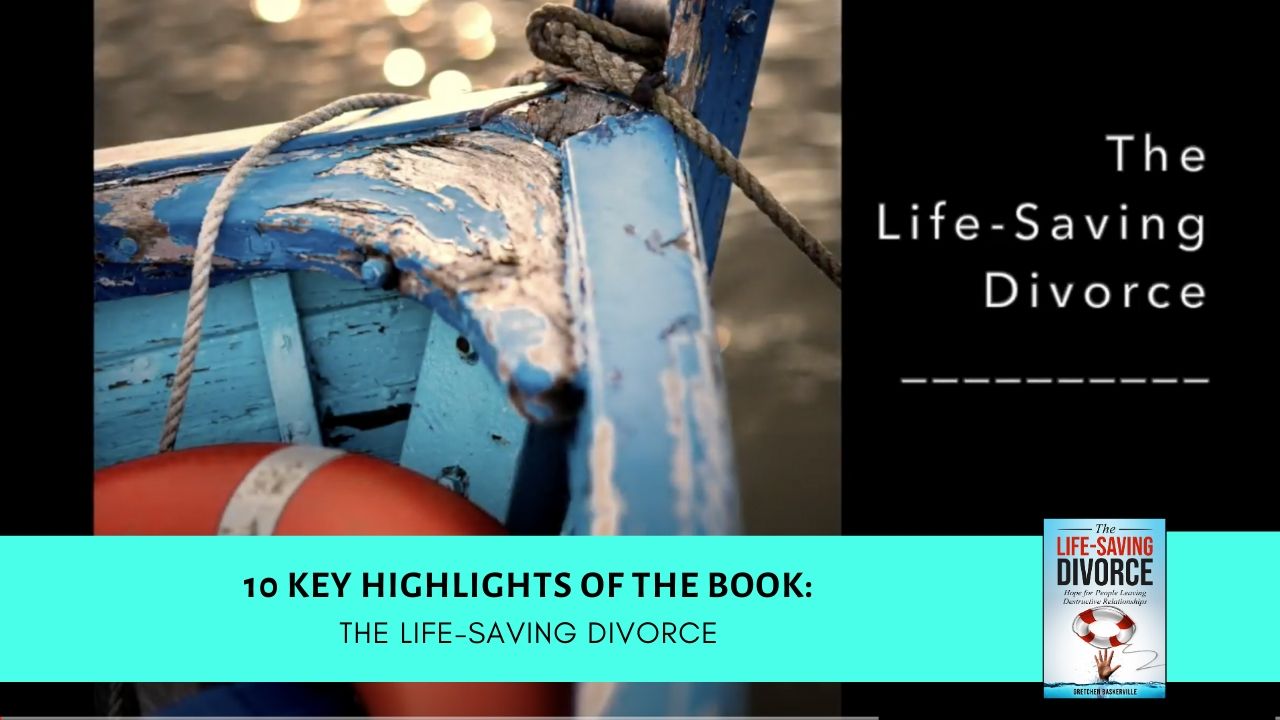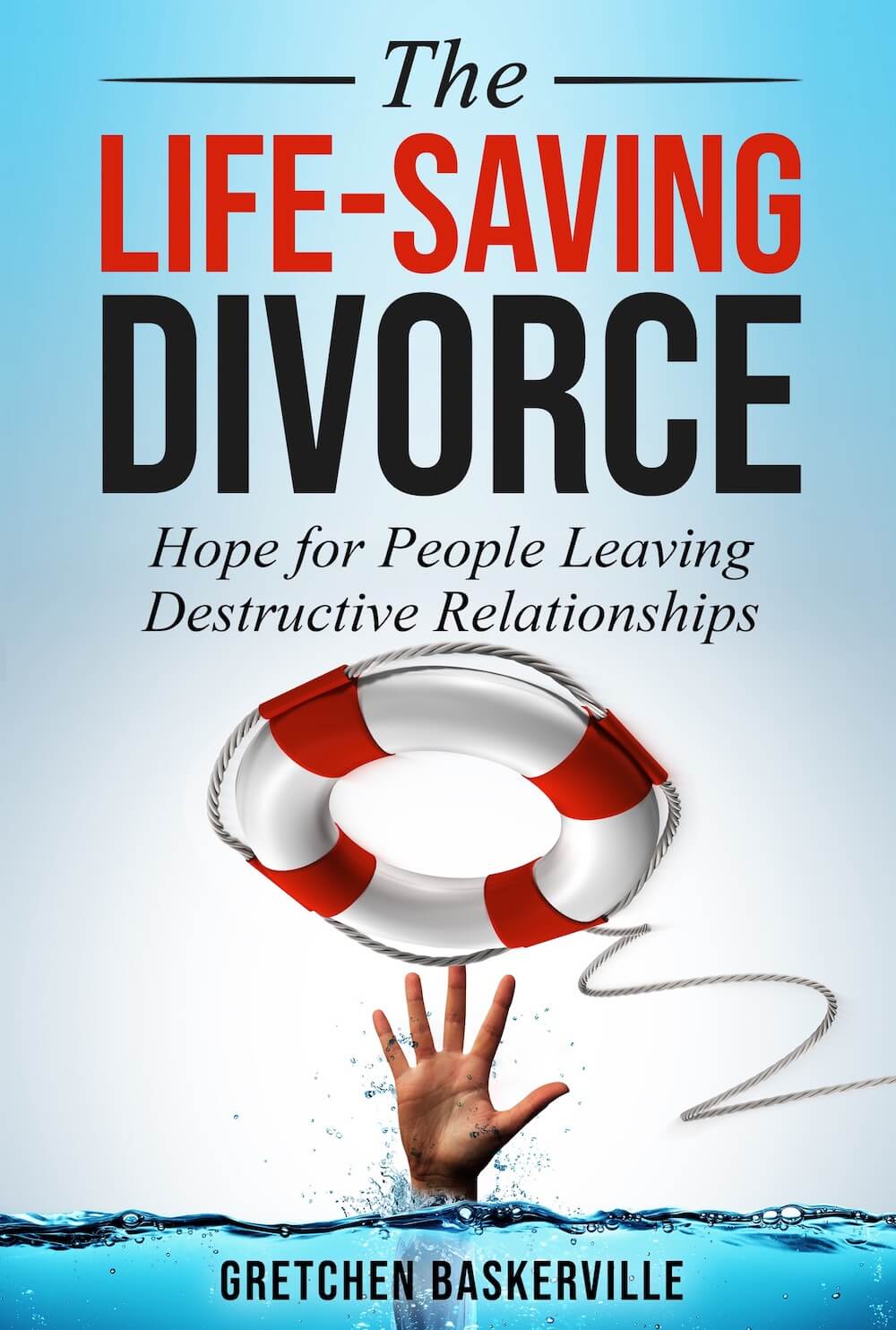I’m sure you’re busy and you don’t have time to read an entire 446-page book. So I’ve done a 15-minute video of highlights for you. Just the key insights from the book and where to start if you want to read more.
VIDEO and TRANSCRIPT (the video is ClosedCaptioned)
Hello, my name is Gretchen Baskerville, and I’m the author of the book, “The Life-Saving Divorce.” I started leading Christian divorce recovery groups in more than 20 years. And I’ve heard countless stories of women and men who’ve gone through divorce. Today I want to give you an overview of my new book “The Life-Saving Divorce: Hope for People Leaving Destructive Relationships.”
This book gives highlights of everything I’ve learned over the past two decades, especially the fact the deeply committed people of faith aren’t quitters who just wanted the easy way out. They believed in the sanctity of marriage and they gave it all they had. If that describes you, this book will give you hope: for your future, for your children, and for your relationship with God. Divorce isn’t the worst thing that can happen to you even though we were taught that it was. Sometimes divorce is a blessing from God to help you escape from a spouse who has a pattern of physical abuse, emotional abuse, infidelity, severe addiction, or neglect.
I want you to know I see your pain. I know what you’ve been through. I know the confusion and I understand the desperation when you’re in an unworkable, destructive relationship and you’ve tried a million things to fix it. My book is a comforting hug. I want you to know you can love God and get a divorce and God will still love you. Really.
So let’s dive in and I’ll explain what I mean by that.
Chapter 1: What is a Life-Saving Divorce?
Nearly half of divorces are “life-saving divorces,” those divorces for really serious problems: a pattern of adultery, physical abuse, emotional abuse, drug or alcohol abuse, addictions or sexual immorality. As a divorce recovery leader for the past 20 years, I’ve listened to some heartbreaking stories of good spouses who tried to hold their marriage together at all costs. The highlights in this chapter? I tell my own story and I tell you what puts some divorces into the life-saving category.
Chapter 2: Understanding divorce and dangerous marriages.
If you’re like me, you ask, “How did I ever get into this?” How many dangerous marriages are there? Are abuse, infidelity, and addictions common? And how do I keep my children from getting into bad marriages? What role do age and education play? And how do social and religious pressures such as legalism affect marriage quality? Why is the divorce rate declining, not rising, like we were always told? And how does no-fault divorce affect the rates of suicide and domestic violence? The highlights in this chapter? the things you can’t miss are I tell about a Christian premarital workbook I used before I got married… a book that actually assumed all Christian marriages would be fine, and never mentioned a single bad behavior that would lead you to call off the wedding. I also explain how divorce reduces the suicide rate of wives by about 20 percent, and I explain four research studies that say that nearly half of divorces are for life-saving reasons.
Chapter 3: 27 Myths of Divorce
27 Myths of divorce: Did I try hard enough? Most good spouses tried very hard to make their marriage work. They gave it their all. So this chapter tells you how to respond to 27 common myths: false messages, such as, it “takes two to tango,” “marriage problems are always 50/50.” Or “it’s best to stay for the kids.” This chapter also addresses religious messages such as, “obviously you don’t care about the sanctity of marriage” or “you don’t take the Word of God seriously” or “you must forgive and forget.” The highlights in this chapter include myth kids; Myth 18 saying that the Bible prohibits divorce, and Myth 10 that says that your spouse won’t cheat on you or watch porn if you just give them more sex.
Chapter 4: Am I Being Abused?
Am I being abused? This chapter helps you figure it out: “Is it abuse, or is this a difficult marriage with normal ups and downs?” Some people are confused. They feel scared, even though they’ve never been physically struck. Here are a 150 examples of physical, emotional, sexual, spiritual, and financial abuse and neglect—including explanations of terms like “gaslighting,” the abuse cycle and featuring the power and control diagram.
Chapter 5: How do you know if it’s time to go?
Learn what other people have done. Here is a list of 10 common tipping points, those “aha” moments when people sense it’s time to leave. Only you know what you can take; and only you know when enough is enough. Learn the steps for protecting yourself using safe words. Plus learn the 50 tips to prepare yourself financially, physically, and legally to get to safety. This entire chapter is pure gold, but be sure not to miss that 50-item Escape List and the 10 turning points as well as the story of Jesus from Luke 13.
Chapter 6: What does the Bible say?
We learn that God cares about and protects vulnerable spouses. The Bible says there are several acceptable reasons for divorce: infidelity, physical abuse, emotional abuse, sexual immorality, neglect, and abandonment. This chapter includes key Bible verses as we look at the teachings of Jesus, the Apostle Paul, and the law of Moses, as well as the Jewish customs and culture in biblical times. The highlights in this chapter are that you discover that God really does allow life-saving divorces; that God Himself is a divorcee; and that remarriage after divorce was acceptable and even required at the time of Jesus.
Chapter 7: Raising kids after divorce.
Most children turn out just fine after divorce. nearly eight in ten children of divorced parents have no serious social, emotional, or psychological problems. More than nine in ten have no drug or alcohol problems. Is divorce hard on them? Yes, of course. But if you’re in a high- distress marriage ,even if there’s no screaming, fist-pounding, or overt conflict, it’s likely better for your children if you divorce rather than to stay in a tension-filled home where you’re all walking on eggshells. The highlight in Part one: The six studies that show that most kids turn out fine after divorce and the quotes from researchers, especially the Christian pro-family researchers who admit that it’s better to take the kids and leave a destructive home. And the tips on the seven common mistakes that single parents make and how to fix them. I tell a funny story about my own kids eating way too much junk food, and playing way too many video games, and still turning out great. About 1 in 10 divorces that go to court multiple times are not normal. They involve a hostile ex-spouse, perhaps a narcissist or a sociopath, who attacks with vitriol, threats, name-calling, multiple court appearances, stalking, false accusations with no evidence, parental alienation, or years of child custody battles. The highlights of Part children in these situations, what to say and not to say, how to document your ex’s behavior so you can protect yourself better.
Chapter 8: Safe Churches and Friends.
Nearly one in three church-going Christians who divorce switched to another church during the process. They love God but they worry about the judgment and gossip. Safe friends and a safe religious fellowship can be an encouragement. When you go through a divorce, some good friends may walk away. Some may cast judgment on you. And it’s important to find supportive people who’ve walked in your shoes. This chapter helps you identify pastors and friends who are safe. The key highlights? The dangers of getting counseling from a person who thinks all marriages can be fixed if the godly spouse just tries harder. There’s a story on page 322 that’s unbelievable.
Chapter 9: Men As Victims of Abuse and Betrayal.
For every seven women who are abused there is at least one man. In this chapter we look at the stories of two men’s life-saving divorces from wives who were abusive or adulterous. These men explain what kept them in these long marriages, and how they finally realized it was over. Men often feel shame about being abuse victims, and they deserve to be heard, cared for, and understood. The key highlights? Don’t miss “David’s” story. It involves no physical violence, yet it’s one of the most painful interviews I did in preparation for this book.
Chapter 10: Moving on and finding happiness again.
Although those first two or three years are stressful, you can survive. Shock, anger, fear, worry, and loneliness are part of the process. Recovering from trauma takes time. This chapter will help you rebuild your self-respect and find your separate identity. Find your voice and become better at protecting yourself and your kids. Discover why those who get life-saving divorces are likely to be happier than if they had stayed—whether they remarry or decide to stay single. The highlights in this chapter? Be sure to read the section on anger and forgiveness. It’s so important to identify the injuries and to be angry about them first. Without that, forgiveness is shortchanged. And be sure to read the section about slander. Is it a sin to tell your story? No, this chapter defines the legal word “slander,” and says you are free to tell your story, in fact, it’s part of the healing process. So that’s the overview of the book.
FREE BONUS: Free download: “7 effective ways to deal with criticism when you divorce.”
As a small token of my thanks for listening, I’d like to offer a free bonus gift for you. Just go to www.lifesavingdivorce.com/free The life-saving PDF is called “7 effective ways to deal with criticism when you divorce.” Let’s face it, no-one likes to be criticized, but it’s a fact of life. When you finally face the reality that your marriage may be over, one of your biggest worries is how will people respond. Having facts will give you confidence and peace in the midst of the storm. Your friends may be well-meaning, but often they are ill informed about divorce and the effect of divorce on children. The 7 tips in this fact sheet will bring you strength and courage. It explains (1) how many divorces are for very serious reasons not frivolous ones; (2) why it’s better in some cases for kids if you leave rather than staying; (3) why kids of divorce are not likely to have drug and alcohol problems; (4) why your divorce probably won’t cause your children to divorce, and more. Again go to www.lifesavingdivorce.com/FREE.
Popular posts:
One Woman’s Story: Adultery, Prayer, and the Bible
The Bible Doesn’t Say “God hates Divorce”—it’s not in the Hebrew text
Bible verses that condone divorce for serious reasons, including mental abuse.
The 27 myths of divorce that aren’t likely true for godly Christians.
“He Never Hit Me”: Interview with a woman whose husband emotionally abused and neglected her
10 Turning Points: What is the “Last Straw” for Most Devout Christians. See One, Two, Three.
Children and Divorce: Why life-saving divorce is very good for children
How do I start dating again? I worry I’ll never find anyone.
Examples of 150 examples of types of abuse (physical, emotional, sexual, financial, and neglect) and explaining the term “gaslighting,” along with many first-person stories, read Chapter 4 in the Life-Saving Divorce.
For a diagram of the Duluth Wheel of Power and Control and The Abuse Cycle, read Chapter 4.
For more on the myths of divorce, buy the Life-Saving Divorce.
As an Amazon Associate I earn from qualifying purchases.



 :
:
 Buy PDF
Buy PDF